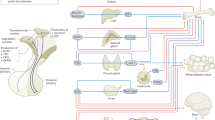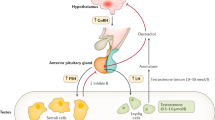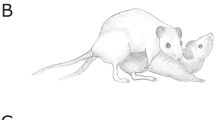Abstract
Animal experiments have suggested that the pineal gland produces an anti-gonadotropic hormone. The hamster, for example, undergoes reproductive collapse when kept in short-day periods, an effect which is abolished by pinealectomy1. Although there is little direct evidence about the endocrine role of the pineal gland in man, it has been noted that tumours of the pineal gland in young boys are associated with precocious puberty and the human pineal gland has been suggested to produce a substance that holds sexual maturation in check2. This observation has been extended by Kitay3, who has shown that destructive tumours are associated with precocious puberty whereas hyperactive tumours are associated with delayed puberty. However, no studies have described any change of pineal function with normal puberty. Because two pineal indoles, melatonin4 and methoxytryptophol5, have been shown to be antigonadotropic when administered to animals6–10, we have now measured them in schoolchildren. Our findings show that in young boys there is an abrupt fall in the concentration of melatonin with advancing development suggesting that it may play an important physiological role in the control of human puberty.
This is a preview of subscription content, access via your institution
Access options
Subscribe to this journal
Receive 51 print issues and online access
$199.00 per year
only $3.90 per issue
Buy this article
- Purchase on Springer Link
- Instant access to full article PDF
Prices may be subject to local taxes which are calculated during checkout
Similar content being viewed by others
References
Hoffman, R. A. & Reiter, R. J. Science 142, 1609 (1965).
Heubner, O. Dt. med. Wschr, 24, 214 (1899).
Kitay, J. I. Clin. Endocr. 14, 622 (1954).
Lerner, A. B., Case, J. D. & Heinzelman, R. V. J. Am. chem. Soc. 81, 6084 (1959).
McIsaac, W. M., Farrell, G., Taborsky, R. G., Taylor, A. N. Science 148, 102 (1965).
Tamarkin, L., Hollister, C. W., Lefebvre, N, G. & Goldman, B.D. Science 198, 953 (1977).
Martin, J. E., Engel, J. N. & Klein, D. C. Endocrinology 100, 675 (1977).
MacPhee, A. A., Cole, F.E. & Rice, B. F. J. clin. Endocr. Metab. 40, 688 (1975).
McIsaac, W.M., Taborsky, R. G. & Farrell, G. Science 145, 63 (1964).
Hipkin, L. J. J. Endocr. 48, 287 (1970).
Tanner, J. M. in Growth at Adolescence, 2nd edn (Blackwell, Oxford and Thomas, Springfield, 1962).
Leone, R. M. et al. J. Endocr. 82, 243 (1979).
Leone, R. M. et al. Prog. Brain Res. (in the press).
Tanner, J. M. Hum. Biol. 23, 93 (1951).
Fevre, M., Segel, T., Marks, J.F. & Boyar, R. M. J. clin. Endocr. Metab. 47, 1383 (1978).
Boyar, R. et al. New. Engl. J. Med. 287, 582 (1972).
Lerner, A. B. & Wright, R. M. Methods biochem. Analysis 8, 295 (1960).
Hoffman, K. J. comp. Physiol. 85, 267 (1973).
Nordlund, J. J. & Lerner, A. B. J. clin. Endocr. Metab. 45, 768 (1977).
Author information
Authors and Affiliations
Rights and permissions
About this article
Cite this article
Silman., R., Leone, R., Hooper, R. et al. Melatonin, the pineal gland and human puberty. Nature 282, 301–303 (1979). https://doi.org/10.1038/282301a0
Received:
Accepted:
Issue Date:
DOI: https://doi.org/10.1038/282301a0
This article is cited by
-
Age-related changes in the gut melatonin levels and its possible role in the regulation of feeding and digestibility, with the development of the gut from fingerling to adult stages of carp, Catla catla
Journal of Comparative Physiology B (2023)
-
Cloning, tissue distribution, mRNA expression and functional analysis of circadian clock gene per2 from the high-latitude Amur minnow (Phoxinus lagowskii)
Aquaculture International (2023)
-
Melatonin, an endogenous hormone, modulates Th17 cells via the reactive-oxygen species/TXNIP/HIF-1α axis to alleviate autoimmune uveitis
Journal of Neuroinflammation (2022)
-
Impact of sleep patterns upon female neuroendocrinology and reproductive outcomes: a comprehensive review
Reproductive Biology and Endocrinology (2022)
-
Impact of Exogenous Melatonin on Sleep and Daytime Functioning in Healthy, Typically Developing Adolescents
Current Sleep Medicine Reports (2022)
Comments
By submitting a comment you agree to abide by our Terms and Community Guidelines. If you find something abusive or that does not comply with our terms or guidelines please flag it as inappropriate.



